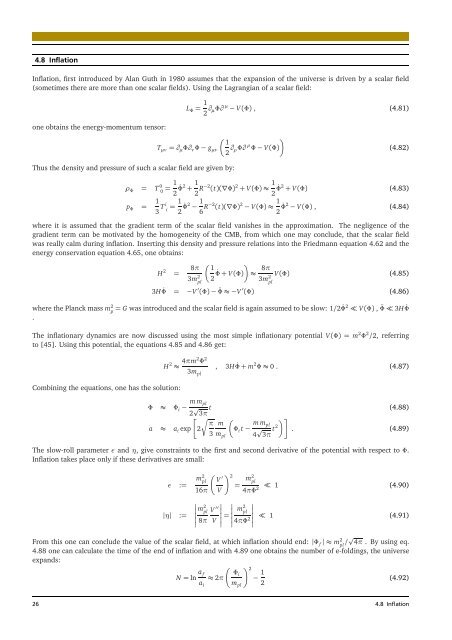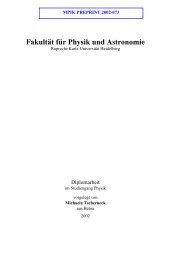Master Thesis
Master Thesis
Master Thesis
Create successful ePaper yourself
Turn your PDF publications into a flip-book with our unique Google optimized e-Paper software.
4.8 Inflation<br />
Inflation, first introduced by Alan Guth in 1980 assumes that the expansion of the universe is driven by a scalar field<br />
(sometimes there are more than one scalar fields). Using the Lagrangian of a scalar field:<br />
one obtains the energy-momentum tensor:<br />
L Φ= 1<br />
2 ∂ µΦ∂ µ − V(Φ) , (4.81)<br />
�<br />
1<br />
T µν=∂ µΦ∂νΦ− g µν<br />
2 ∂ρΦ∂ ρ �<br />
Φ− V(Φ)<br />
Thus the density and pressure of such a scalar field are given by:<br />
(4.82)<br />
ρΦ = T 0 1<br />
0 =<br />
2 ˙Φ 2 + 1<br />
2 R−2 (t)(∇Φ) 2 + V(Φ)≈ 1<br />
2 ˙Φ 2 + V(Φ) (4.83)<br />
pΦ = 1 1 i<br />
T i =<br />
3 2 ˙Φ 2 − 1<br />
6 R−2 (t)(∇Φ) 2 − V(Φ)≈ 1<br />
2 ˙Φ 2 − V(Φ) , (4.84)<br />
where it is assumed that the gradient term of the scalar field vanishes in the approximation. The negligence of the<br />
gradient term can be motivated by the homogeneity of the CMB, from which one may conclude, that the scalar field<br />
was really calm during inflation. Inserting this density and pressure relations into the Friedmann equation 4.62 and the<br />
energy conservation equation 4.65, one obtains:<br />
H 2 =<br />
8π<br />
3m 2<br />
pl<br />
�<br />
1<br />
2 ˙Φ+<br />
�<br />
V(Φ) ≈ 8π<br />
3m2 V(Φ) (4.85)<br />
pl<br />
3H ˙Φ = −V ′ (Φ)− ¨Φ≈−V ′ (Φ) (4.86)<br />
where the Planck mass m 2<br />
p = G was introduced and the scalar field is again assumed to be slow: 1/2˙Φ 2 ≪ V(Φ) , ¨Φ≪3H ˙Φ<br />
.<br />
The inflationary dynamics are now discussed using the most simple inflationary potential V(Φ)=m 2 Φ 2 /2, referring<br />
to [45]. Using this potential, the equations 4.85 and 4.86 get:<br />
Combining the equations, one has the solution:<br />
H 2 ≈ 4πm2 Φ 2<br />
3m pl<br />
, 3H ˙Φ+ m 2 Φ≈0 . (4.87)<br />
Φ ≈ Φi− m mpl 2 � t (4.88)<br />
3π<br />
��<br />
�<br />
π m<br />
a ≈ ai exp 2 Φi t−<br />
3<br />
m mpl 4 � 3π t2<br />
��<br />
. (4.89)<br />
m pl<br />
The slow-roll parameterεandη, give constraints to the first and second derivative of the potential with respect toΦ.<br />
Inflation takes place only if these derivatives are small:<br />
ε :=<br />
|η| :=<br />
m 2<br />
pl<br />
16π<br />
�<br />
�<br />
�<br />
�<br />
�<br />
m 2<br />
pl<br />
8π<br />
� V ′<br />
V<br />
� 2<br />
V ′′<br />
�<br />
�<br />
�<br />
�<br />
V�<br />
=<br />
�<br />
�<br />
�<br />
�<br />
�<br />
=<br />
m2 pl<br />
≪ 1 (4.90)<br />
2 4πΦ<br />
m 2<br />
pl<br />
4πΦ2 �<br />
�<br />
�<br />
� ≪ 1 (4.91)<br />
�<br />
From this one can conclude the value of the scalar field, at which inflation should end:|Φ f|≈m 2<br />
pl /�4π . By using eq.<br />
4.88 one can calculate the time of the end of inflation and with 4.89 one obtains the number of e-foldings, the universe<br />
expands:<br />
N= ln a f<br />
a i<br />
≈ 2π<br />
� Φi<br />
m pl<br />
� 2<br />
− 1<br />
2<br />
(4.92)<br />
26 4.8 Inflation
















